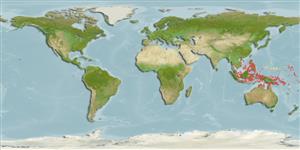分类 / Names
俗名 | 同种异名 | Catalog of Fishes(属, 种) | ITIS | CoL | WoRMS | Cloffa
Environment: milieu / climate zone / depth range / distribution range
生态学
海洋; 淡水; 半咸淡水 居于水底的; 非产卵性溯降河的 (Ref. 59012); 深度上下限 0 - 5 m (Ref. 86942). 熱帶; 22°C - 28°C (Ref. 12468); 19°N - 15°S
Asia and Oceania: Sri Lanka, Indonesia, Philippines, New Guinea, Admiralty Islands, Micronesia (Pohnpei, Caroline Islands) and Australia. Reported from New Caledonia (Ref. 13246).
亞洲與大洋洲: 斯里蘭卡,印尼,菲律賓,新幾內亞,海軍群島,密克羅尼西亞 (波納佩島, 加羅林群島) 與澳洲。 記錄來自新加勒多尼亞了。 (參考文獻 13246)
大小 / 重量 / 年龄
Maturity: Lm ? range ? - ? cm
Max length : 34.0 cm SL 雄鱼/尚未辨别雌雄; (Ref. 44894); common length : 15.0 cm SL 雄鱼/尚未辨别雌雄; (Ref. 44894)
背棘 (总数) : 7; 背的软条 (总数) : 8; 臀棘: 1; 臀鳍软条: 8.
Found in freshwater, estuaries, inshore and mangrove (Ref. 86252). Adults occur on soft mud bottoms of rainforest creeks to elevations of at least 150 m. (Ref. 2847, 44894). They favor undercut banks for retreat. Probably has a pelagic marine larval stage (Ref. 44894).
生活于雨林小溪到海拔至少的软泥底 150 公尺。 (参考文献 2847,44894). 发现于河了。 (参考文献 6371) 对于休息寓所喜欢堤岸下。 可能有一个大洋性的海洋幼鱼时期。 (参考文献 44894)
Life cycle and mating behavior
成熟度 | 繁殖 | 产卵场 | 卵 | 孕卵数 | 仔鱼
亞洲與大洋洲: 斯里蘭卡,印尼,菲律賓,新幾內亞,海軍群島,密克羅尼西亞 (波納佩島, 加羅林群島) 與澳洲。 記錄來自新加勒多尼亞了。 (參考文獻 13246)
Allen, G.R., 1991. Field guide to the freshwater fishes of New Guinea. Publication, no. 9. 268 p. Christensen Research Institute, Madang, Papua New Guinea. (Ref. 2847)
世界自然保护联盟红皮书 (Ref. 130435: Version 2024-1)
人类利用
工具
特别资料
下载 XML
网络资源
Estimates based on models
Preferred temperature (Ref.
123201): 27.4 - 29.4, mean 28.8 °C (based on 981 cells).
Phylogenetic diversity index (Ref.
82804): PD
50 = 1.0000 [Uniqueness, from 0.5 = low to 2.0 = high].
Bayesian length-weight: a=0.01000 (0.00420 - 0.02379), b=3.08 (2.88 - 3.28), in cm total length, based on LWR estimates for this (Sub)family-body shape (Ref.
93245).
营养阶层 (Ref.
69278): 3.5 ±0.6 se; based on size and trophs of closest relatives
回复力 (Ref.
120179): 低的, 最小族群倍增时间4.5 - 14 年 (Preliminary K or Fecundity.).
Fishing Vulnerability (Ref.
59153): Low to moderate vulnerability (31 of 100).
